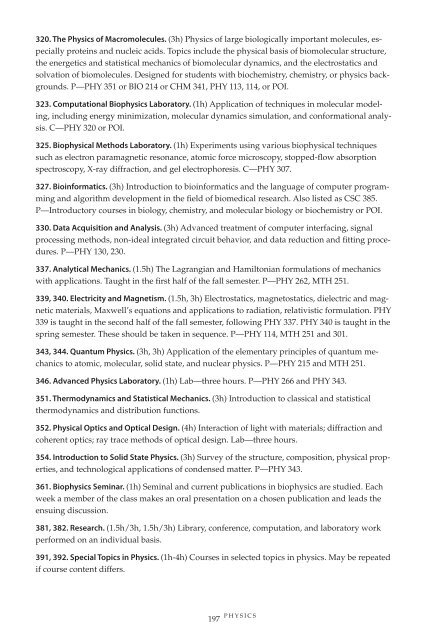theundergraduateschoo ls - Wake Forest University
theundergraduateschoo ls - Wake Forest University
theundergraduateschoo ls - Wake Forest University
You also want an ePaper? Increase the reach of your titles
YUMPU automatically turns print PDFs into web optimized ePapers that Google loves.
320. The Physics of Macromolecules. (3h) Physics of large biologically important molecules, especially<br />
proteins and nucleic acids. Topics include the physical basis of biomolecular structure,<br />
the energetics and statistical mechanics of biomolecular dynamics, and the electrostatics and<br />
solvation of biomolecules. Designed for students with biochemistry, chemistry, or physics backgrounds.<br />
P—PHY 351 or BIO 214 or CHM 341, PHY 113, 114, or POI.<br />
323. Computational Biophysics Laboratory. (1h) Application of techniques in molecular modeling,<br />
including energy minimization, molecular dynamics simulation, and conformational analysis.<br />
C—PHY 320 or POI.<br />
325. Biophysical Methods Laboratory. (1h) Experiments using various biophysical techniques<br />
such as electron paramagnetic resonance, atomic force microscopy, stopped-flow absorption<br />
spectroscopy, X-ray diffraction, and gel electrophoresis. C—PHY 307.<br />
327. Bioinformatics. (3h) Introduction to bioinformatics and the language of computer programming<br />
and algorithm development in the field of biomedical research. A<strong>ls</strong>o listed as CSC 385.<br />
P—Introductory courses in biology, chemistry, and molecular biology or biochemistry or POI.<br />
330. Data Acquisition and Analysis. (3h) Advanced treatment of computer interfacing, signal<br />
processing methods, non-ideal integrated circuit behavior, and data reduction and fitting procedures.<br />
P—PHY 130, 230.<br />
337. Analytical Mechanics. (1.5h) The Lagrangian and Hamiltonian formulations of mechanics<br />
with applications. Taught in the first half of the fall semester. P—PHY 262, MTH 251.<br />
339, 340. Electricity and Magnetism. (1.5h, 3h) Electrostatics, magnetostatics, dielectric and magnetic<br />
materia<strong>ls</strong>, Maxwell’s equations and applications to radiation, relativistic formulation. PHY<br />
339 is taught in the second half of the fall semester, following PHY 337. PHY 340 is taught in the<br />
spring semester. These should be taken in sequence. P—PHY 114, MTH 251 and 301.<br />
343, 344. Quantum Physics. (3h, 3h) Application of the elementary principles of quantum mechanics<br />
to atomic, molecular, solid state, and nuclear physics. P—PHY 215 and MTH 251.<br />
346. Advanced Physics Laboratory. (1h) Lab—three hours. P—PHY 266 and PHY 343.<br />
351. Thermodynamics and Statistical Mechanics. (3h) Introduction to classical and statistical<br />
thermodynamics and distribution functions.<br />
352. Physical Optics and Optical Design. (4h) Interaction of light with materia<strong>ls</strong>; diffraction and<br />
coherent optics; ray trace methods of optical design. Lab—three hours.<br />
354. Introduction to Solid State Physics. (3h) Survey of the structure, composition, physical properties,<br />
and technological applications of condensed matter. P—PHY 343.<br />
361. Biophysics Seminar. (1h) Seminal and current publications in biophysics are studied. Each<br />
week a member of the class makes an oral presentation on a chosen publication and leads the<br />
ensuing discussion.<br />
381, 382. Research. (1.5h/3h, 1.5h/3h) Library, conference, computation, and laboratory work<br />
performed on an individual basis.<br />
391, 392. Special Topics in Physics. (1h-4h) Courses in selected topics in physics. May be repeated<br />
if course content differs.<br />
P H Y S I C S<br />
197






